skip to main |
skip to sidebar
Introduction
I've always found Liverpool a special place. In 2009, I wrote my first post about the City called simply Liverpool. Since then, I've added a number of posts with a Liverpool theme. I summarised my posts up to June 2014 in the post Liverpool (again). Liverpool's location on the west coast of England, facing Ireland and the New World, encouraged its growth as a major seaport. By 1927 the dock system extended for over 6 miles along the east side of the estuary of the River Mersey. The panorama of the docks below in the 1950s was included in the post The Liverpool Overhead Railway (where there is a larger version).

Notes on the History of Liverpool Docks
In the 18th century, the Old Dock (subsequently filled in), Canning Dock, Salthouse Dock, Georges Dock Dukes Dock, Kings Dock and Queens Dock were built, all upstream (south) of the present Pierhead. In 1810 John Foster Senior added Princes Dock. In 1824 the remarkable Jesse Hartley (1780 - 1860) became Dock Engineer and, by 1860, had increased the size of Liverpool's docks from 46 acres to 212 acres. All the old docks were modernised and he was responsible for the design and execution of numerous new docks both to the north (Clarence Dock, Waterloo Dock, Trafalgar Dock, Stanley Dock, Collingwood Dock, Nelson Dock, Bramley-Moore Dock, Salisbury Dock, Wellington Dock, Sandon Dock, Huskisson Dock, Canada Dock) and to the south (Brunswick Dock, Coburg Dock, Albert Dock, Toxteth Dock, Wapping Dock)
Hartley's background was as a stonemason and the quality of the work he supervised was so good that it can be admired even today. He had a fondness for so-called 'Cyclopean' masonry using irregularly-shaped stones carefully fitted together. In constructing quay walls, huge stones might be used but a similar style with smaller stones was also used extensively.
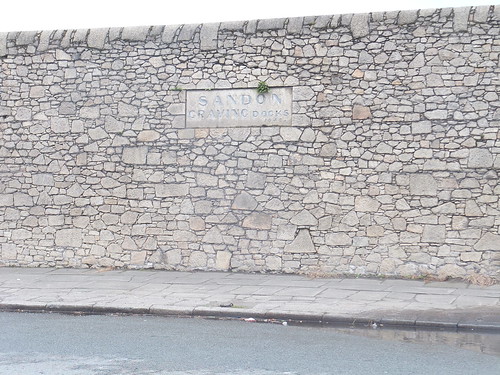 Enclosing wall for Sandon Graving Docks, built 1848, featuring Jesse Hartley's 'Cyclopean' masonry.
Enclosing wall for Sandon Graving Docks, built 1848, featuring Jesse Hartley's 'Cyclopean' masonry.
When Hartley used 'worked' stone, the accuracy he demanded was amazing. His architectural style is sometimes called 'eclectic' but I'm tempted to call it 'eccentric'. He mixed styles and materials in a flamboyant manner, but work was always carried out to the highest quality.
Hartley was an innovator in dock design. He constructed huge locks to separate the river from groups of docks, allowing the water level to be kept constant in the docks to facilitate loading and unloading of ships. But the locks allowed ships to enter or leave the docks at any state of the tide.
 A Lock Keeper's Office by Jesse Hartley, illustrating his attention to detail and build quality.
A Lock Keeper's Office by Jesse Hartley, illustrating his attention to detail and build quality.
Jesse Hartley also pioneered the concept of Enclosed Docks. By providing substantial, tall dock walls with access to the docks only through manned gates, theft was significantly reduced.
 Jesse Hartley Dock Wall in stone with In-Out gates flanked by round turret-like stone pillars (slotted for sliding gates) with matching stone Gatekeeper's Office (incorporating a chimney).
Jesse Hartley Dock Wall in stone with In-Out gates flanked by round turret-like stone pillars (slotted for sliding gates) with matching stone Gatekeeper's Office (incorporating a chimney).
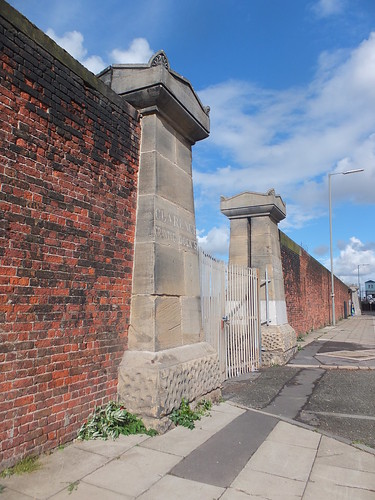
Jesse Hartley Dock Wall in brick with gateway flanked by stone pillars (Clarence Graving Docks).
An example of Jesse Hartley's architectural range is the 6-sided clock tower at the entrance to Salisbury Dock, completed in 1848. It's called officially Victoria Tower and is described on Wikipedia here. Listed Grade II it awaits the refurbishment promised by Peel Ports. There's further information on the Tower here.
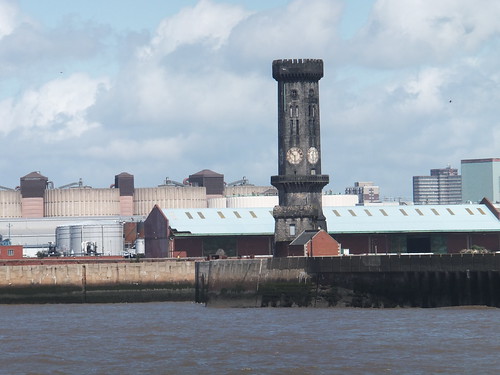 Victoria Tower from the river.
Victoria Tower from the river.
The prolific Jesse Hartley was also the Dock Engineer for Birkenhead's docks. There's a brief post on a walk around Birkenhead's docks here.
Jesse Hartley died in 1860 and his immediate successor was his son, John Hartley. Over the next 40 years, Liverpool Docks continued to expand both to the north (Brocklebank Dock, Langton Dock, Alexandra Dock, Hornby Dock) and the south (Herculaneum Dock, Harrington Dock). In 1913, Gladstone Graving Dock (a Dry Dock) was opened, followed by Gladstone Dock in 1927.
This represented the zenith of dock development in Liverpool. In the 1950s, the now-familiar Shipping Container was introduced. Containerisation reduced the need for traditional docks like Liverpool. In 1972, a new container dock was built to the north of Gladstone Dock, Seaforth Dock (sometimes called 'Royal Seaforth Dock'). Some of the old docks have been filled-in to permit new developments but most of the quays and enclosed areas of water remain but, for the most part, much less used.
Liverpool Docks were operated by the Mersey Docks and Harbour Board for a long period and there's a brief post here. Today, a reduced set of docks is operated by the Mersey Docks and Harbour Company, part of Peel Ports.
The Peel Ports website on Liverpool is here. The emphasis now is on the container post at Seaforth, which rendered many of the earlier docks redundant. Peel Ports are also completing a new deepwater container port called 'Liverpool2', due to open in 2015, which they say will handle "two 380m mega post-panamax vessels simultaneously". There's more information here and an excellent explanation of the terms 'Panamax' and 'Post-Panamax' in Wikipedia here.
I consider myself fortunate that I saw Liverpool Docks before the Containerisation Revolution brought major changes to its role.
Related articles on other sites
Jesse Hartley (Wikipedia).
Port of Liverpool (Wikipedia).
List of Liverpool Docks (Wikipedia).
Liverpool Docks (Victoria County History).
Mersey Docks 1949.
Seaforth Dock (Wikipedia).
Peel Ports, Liverpool.
Peel Ports, Liverpool2
Related posts on this site
Liverpool.
Liverpool (again).
The Liverpool Overhead Railway.
Birkenhead and New Brighton by train (Part 2)
(On foot around Birkenhead's Docks).
The Mersey Docks and Harbour Board.
On foot around Liverpool Docks.
Books
[1] 'Jesse Hartley - Dock Engineer to the Port of Liverpool 1824-60' by Nancy Ritchie-Noakes, published by National Museums and Galleries on Merseyside (ISBN 0 906367 05 0).
[2] 'L.N.W.R. and the M.D.& H.B. - The History of the Dock Lines from the Records' by J. C. James, Limited Edition published c1981.
[3] 'Prince's Dock - A Magnificent Monument of Mural Art' by Adrian Jarvis published 1991 by Merseyside Port Folios (ISBN 0 9516129 0 5).
[4] 'Liverpool and its Canal' by Mike Clarke and Allison Hewitt published 1992 by Merseyside Port Folios (ISBN 0 9516129 3 X).
[5] 'An Illustrated History of Liverpool's Railways' by Paul Anderson, published Irwell Press (ISBN 1-871608-68-6).
My Pictures
Liverpool Docks.
Liverpool.
On Saturday 4th October 2014, having earlier travelled on most of the former Cheshire Lines Committee (CLC) routes which still have a passenger service (as described in the post here), I transferred to the Northern Line of Merseyrail to explore the short section of the former CLC line from Hunts Cross to Liverpool. Later, I used the Wirral Line from James Street to West Kirby and back before finally travelling to Ellesmere Port (as described in the post More Merseyrail).
The line from Ellesmere Port to Helsby still has a passenger service, operated by Northern Rail, but it's confined to a couple of trains each way early morning and two more round trips in the afternoon. Otherwise, you can catch a Merseyrail electric to Hooton, change for Chester then change again for Helsby. Instead of a ten minute direct journey, it can take the best part of an hour or longer, depending upon connections.
Ellesmere Port station
I was intrigued that what was a double track wayside station now operates as two back-to-back terminals.
 Ellesmere Port station. Merseyrail electrics use the far platform (platform 1); Northern Rail trains use the near platform.
Ellesmere Port station. Merseyrail electrics use the far platform (platform 1); Northern Rail trains use the near platform.
Merseyrail trains arrive in platform 1 on the down line and, when unloading and loading has taken place and the Driver and Guard have changed ends, the train departs via a trailing crossover at the Hooton end of the station (shown in the photograph below) to reach the Up line for the journey back to Liverpool. There's also a trailing connection in the Down line to the dock branch. This was originally closed over 20 years ago but was re-opened as a railhead in 2011 by Peel Ports and Quality Freight. A 2-aspect colour light signal controls departures onto the Up line; the subsidiary aspect is presumably for movements onto the dock branch. In the 'four foot' note the traction impedance bond and (foreground) the Train Stop Loops forming part of the Train Protection and Warning System (TPWS) installation.
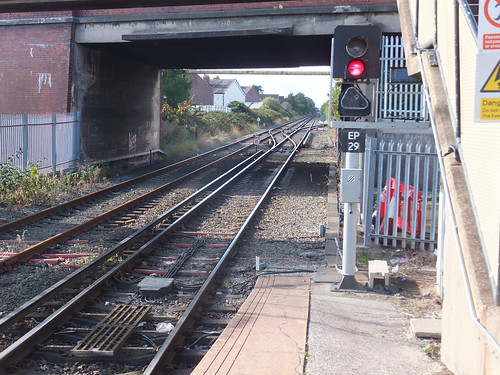 Ellesmere Port: View from platform 1 looking towards Hooton, showing the crossover used by electric trains. The single line diverging to the right serves the much-altered dock branch.
Ellesmere Port: View from platform 1 looking towards Hooton, showing the crossover used by electric trains. The single line diverging to the right serves the much-altered dock branch.
Looking towards Helsby, we're suddenly in the world of semaphore signalling (with a huddle of ground disc signals) operated from a manual signal box (a composite design with a brick base and a British Railways Standard top. The picture below is the view from the station footbridge looking towards Helsby. The third rail on platform 1 (left of picture) ends abruptly at the platform ramp. In the 'four foot' on the Up line, there appears to be an AWS Magnet to serve as a warning to trains approaching platform 2.
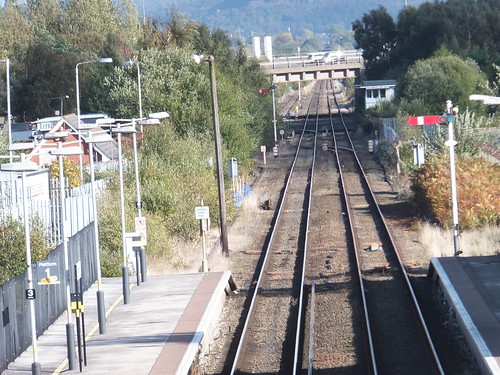 Ellesmere Port: View from station footbridge looking towards Helsby.
Ellesmere Port: View from station footbridge looking towards Helsby.
Ellesmere Port to Helsby
I wasn't too confident that my train for Helsby would materialise but, right on time, I saw the headlights of a Diesel Multiple Unit (DMU) approaching.
On arrival, a few passengers alighted whilst two passengers and I joined the 2-car Class 156. The Driver and Guard changed ends and, with clear signals, we set off through the crossover onto the Down line, crossing over the Shropshire Union Canal near the signal box which proudly claimed to be 'Ellesmere Port No. 4'. I'm afraid it's now the sole survivor of five boxes which once controlled the major complex of sidings serving the docks and oil refineries. After a few minutes, we stopped at Ince and Elton station but I saw no-one get off or on. A few minutes later we made an equally unproductive stop at Stanlow and Thornton. A few more minutes and we stopped at our destination, Helsby.
Helsby Station
With two afternoon departures from Ellesmere Port only 30 minutes apart, I'd already correctly guessed that my train would go back to Ellesmere Port to form the final service. This time, a small cluster of people boarded and the DMU set of back to Ellesmere Port, regaining the Up line through a crossover.
 Helsby Station, with the train I'd arrived on from Ellesmere Port standing in platform 4, ready to return to Ellesmere Port.
Helsby Station, with the train I'd arrived on from Ellesmere Port standing in platform 4, ready to return to Ellesmere Port.
But I'd arranged a few minutes on Helsby station for photography. Of course, I was particularly taken by the LNWR mechanical signal box mounted between platforms 2 and 3. It's the first box I've seen with a locked 'cage' around the access steps (although I think this feature is being introduced more widely). I imagined that this might be to protect the public from a particularly violent breed of signalmen but I'm sure it's actually to protect signalmen from enraged passengers ('customers'?) when they despair of getting to their destination.
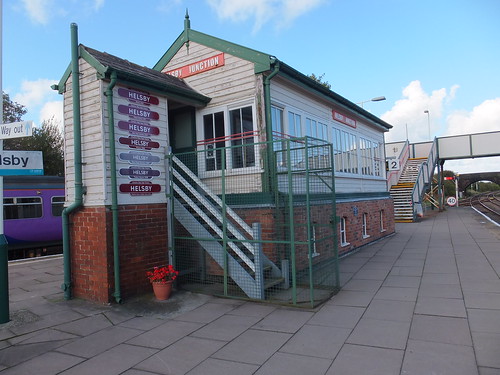 Helsby Junction Signal Box, showing the cage around the access steps.
Helsby Junction Signal Box, showing the cage around the access steps.
The wooden wall of the toilet displays a number of awards in the form of British Railways 'totem' signs recording Helby's success in the Cheshire Best Kept Station competition:-
Winner 2010
Tidiest Station 2011
Best Kept Gardens 2012
Winner 2006
Best Kept Gardens 2007
Tidiest Station 2008
Cheshire West & Chester Award 2009
Helsby is an attractive station and the semaphore signalling appealed to me (around the station area all upper quadrant tubular post signals). I could have waited for the train I'd arrived on to return from Ellesmere Port since it was then booked to go forward to Warrington. However, when an earlier Arriva Trains Wales service arrived from Chester direction bound for Manchester, I decided to take this train to Warrington Bank Quay.
Helsby to Warrington and home
Our first stop was at Frodsham which has a handsome former station building of brick with stone quoins, window surrounds and detailing. Today's travellers are served by an ugly green 'bus shelter'.
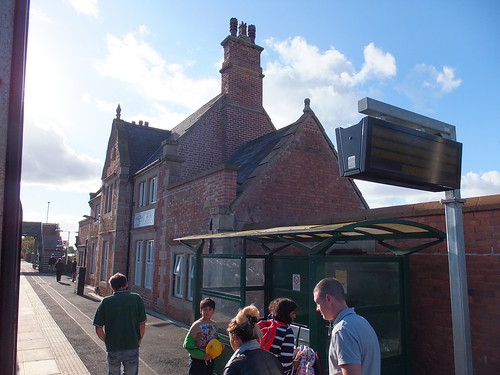 The handsome former station building at Frodsham.
The handsome former station building at Frodsham.
In just over a mile, we came to Frodsham Junction which initially had a double-line junction to Halton Junction on the Weaver Junction - Liverpool main line. A unidirectional single line remains, called the 'Down Chester-Liverpool'. There were once Up and Down Goods Lines extending towards Halton station on the Warrington line. The Up Goods Line survives but Halton station and its signalbox have gone.
We dashed through Sutton Tunnel (over a mile long) and made a brief stop at Runcorn East - another 'bus shelter'. We passed over the West Coast Main Line (WCML), where I spotted a Virgin 'Pedolino' heading quite slowly towards Warrington. Then we slowed on the approach to Acton Grange Junction where our line converged with the WCML and we came to a stand at the colour light protecting the junctions, WN239. After a short wait, we started to move and I found that the signal head and route indicator had been replaced by yet another variation of modern, Light Emitting Diode (LED) signal. The flat panel forming the route indicator looked very odd to my eyes - I'm old enough to remember the Air Raid Precaution (A.R.P.) design signal box at Acton Grange junction and semaphore signals. I always have a vision of a wheezing 'Super D' freight engine dragging a long loose-coupled freight up the gradient on the 'Old Line' towards the signal box. Well, the four tracks with double junctions remain, as does the massive lattice girder bridge carrying the four lines over the Manchester Ship Canal but otherwise the scene has totally changed.
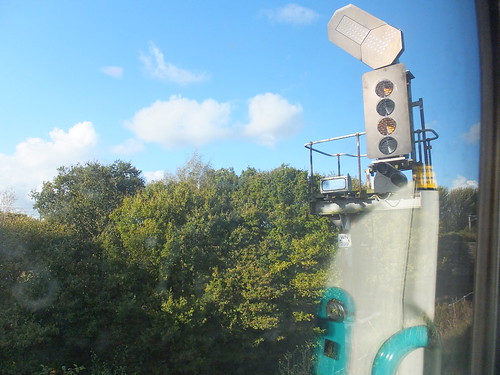 Acton Grange Junction - signal WN239.
Acton Grange Junction - signal WN239.
We were routed onto the Down Main (presumably following the 'Pendolino' which was nowhere in sight) and soon stopped at Warrington where I left the train. I had a few minutes to wait for the London via Birmingham New Street 'Pendolino' which would take me home. Whilst waiting, the Class 156 I'd left a Helsby arrived, discharged a few passengers and set off again, presumably now Empty Stock, on the Down Slow.
I found at least eight old bicycles, repainted, tied to pillars along the platform. Three successive bicycles of the up platform offered a message to passengers on arriving trains - 'Welcome' - 'to' - 'WBQ'. Coming across the last sign first, it took me a few seconds to realise that 'WBQ' was simply 'Warrington Bank Quay'. One of the bicycles carried a sign reading 'Have you reserved your bicycle?' so I'm not sure whether it was a Art Installation, an advert for Virgin's Bicycle Carrying Facilities, or both. It may be only a coincidence that the Warrington Contemporary Arts Festival was being held at the same time.
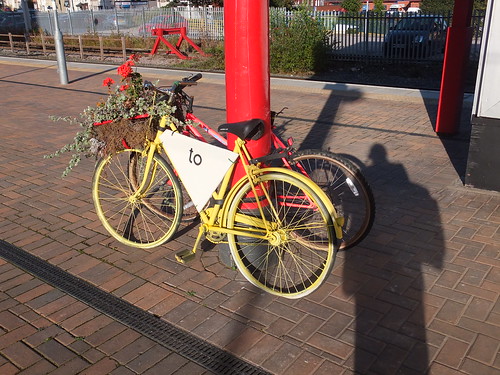 A pair of bicycles at Warrington Bank Quay, incorporating a floral arrangement.
A pair of bicycles at Warrington Bank Quay, incorporating a floral arrangement.
My pictures
Merseyrail.
Ellesmere Port - Helsby line.
Warrington Area rail.
Introduction
The Railway Signal Company, located in Fazakerley, Liverpool supplied the signal boxes and signalling equipment when the Cheshire Lines Committee (CLC) was opened. The Railway Signal Company became part of Westinghouse in 1920 and finally closed in 1974. Some of the company records are preserved in the National Archives as detailed here.
However, the CLC always had a distinctive approach and this was no less true of its signalling installations. The CLC set up signalling workshops in Warrington and became self-sufficient.
The CLC lower quadrant semaphore signals featured large spectacle glasses and the CLC even contrived some odd-looking upper quadrant signals using parts for the lower quadrant signals! In a post about signalling in Burma here I was rather unkind about their use of lower quadrant arms on upper quadrant signals - perhaps I now know where the idea originated.

Glazebrook East Junction in 1962 showing a CLC upper quadrant bracket signal. The left doll is for Manchester, the right for Skelton Junction and Stockport. The two miniature arms read to sidings. Today, the signal has gone, the sidings have gone, the branch to Skelton Junction has gone. The main line and the British Railways Standard signal box remain. (From a photo by G. H. Platt)
Not much of this interesting legacy survives today and my recent dash around the system in the rain described here no doubt missed any signalling 'jewels' which remain. I'm afraid it's mainly British Railways Standard signal boxes and colour light signals now and, of course, the lines that remain are much simplified and many signalboxes have been abolished.
Pre-grouping railway map showing Cheshire Lines Committee routes
The principal CLC routes were:-
1. Liverpool Central to Manchester Central via Warrington Central.
2. Chester to Manchester Central.
3. Halewood/Hunts Cross to Southport Central via Aintree.
4. Glazebrook to Hyde Jn./Godley Jn. via Stockport Tiviot Dale.

Click for larger view. On the above map, CLC routes carry the colours of all three partners:-
Great Northern Railway - Brown
Great Central Railway - White/Red
Midland Railway - Green
Signalling on the CLC in the 1950s
In the 1950s, the CLC routes were mainly controlled by semaphore signals, manual signal boxes and Absolute Block Signalling (although Brunswick had a 45-lever frame plus a small 'NX' control panel and Manchester Central was a Power Box). Nowadays, with many of the lines abandoned and the remaining routes simplified, it's hard to imagine the complexity of the British Railway system even as late as the 1950s. The signal boxes operating on the CLC network in the 1950s are detailed in the John Swift collection (see the section 'Track Diagrams' below) and are listed below.
1. Liverpool Central - Manchester Central
Liverpool Central
Brunswick
Otterspool
Cressington
Garston Central
Hunts Cross West Jn.
Hunts Cross East Jn. (controls a triangular junction with Southport Line - see 3 below)
Halewood West Jn. (Goods Lines only)
Halewood East Jn. (controls a triangular junction with Southport Line - see 3 below)
Hough Green Jn.
Widnes Moor Lane (on Loop Line)
Widnes Central (on Loop Line)
Tanhouse Lane (on Loop Line)
Widnes North
Widnes East Jn.
Sankey
Sankey Jn.
Bewsey (on Loop Line)
Warrington Central (on Loop Line)
Workshops (on Loop Line)
Padgate Jn.
Padgate
Risley West
Risley East
Risley Moss
Dam Lane Jn. (Note A)
Glazebrook West Jn. (Note A)
Glazebrook East Jn. (Junction for Stockport Line)
Irlam
Flixton
Urmston
Trafford Park
Trafford Park Sidings (Goods Lines only)
Trafford Park Jn. (Note B)
Throstle Nest East Junction (Note B)
Cornbrook Sidings (Chester Lines)
Old Trafford Jn. (Chester Lines)
Cornbrook West Junction
Cornbrook Jn. East (LNW Tappet Frame controlling Oxford Road Lines)
Manchester Central (Power Box with Colour Light Signals)
Note A: Dam Lane Jn. and Glazebrook West Jn. control a triangular connection with the GCR Branch to Wigan:-
Glazebrook Moss Jn.
Newchurch Halt (Box Closed)
Culcheth
Lowton St. Marys Jn. (Note C)
Bickershaw Jn.
Bickershaw & Abram
Hindley South (Junction for LNWR Bickershaw Jn, Amberswood West Jn. & Amberswood East Jn.)
Lower Ince
Wigan Central Goods Yard
Note B: Trafford Park Jn. and Throstle Nest East Jn. control a triangular junction with a branch serving both GCR and MR lines:-
Throstle Nest South Jn.
Chorlton
Chorlton Jn. (Junction for MR Withington & West Didsbury)
Wilbraham Road
Fallowfield
Levenshulme
Hyde Road Jn. (controls a triangular junction with Gorton Jn. and Fairfield Jn. on the GCR Manchester - Sheffield line)
Note C: Junction for St. Helens
Edge Green and Golborne Colliery Sdgs.
Haydock Park Racecourse
Ashton in Makerfield
St. Helens Central
2. Chester Northgate to Manchester Central
Chester South Jn. (controls a triangular junction with the GCR lines on the Wirral)
Chester East Jn. (controls a triangular junction with the GCR lines on the Wirral)
Mickle Trafford (Junction with the LNWR/GWR line from Chester to Warrington)
Barrow for Tarvin
Mouldsworth Jn. (Junction for Helsby-Hooton line)
Delamere
Winsford Jn. (Junction for Winsford & Over
Cuddington
Hartford Jn. (Junction for Hartford Jn. LMS
Hartford & Greenbank (controls a triangular junction at Hartford North Jn. with Oakleigh Sidings
Hartford East Jn. (controls a triangular junction at Hartford North Jn. with Oakleigh Sidings
Sandbach Jn. (controls a triangular junction with the line to Sandbach).
Northwich Central
Northwich East
Lostock Gralam
Halford Hall (Closed)
Plumley West
Plumley
Knutsford West
Knutsford East
Shaw Heath
Mobberley
Ashley
Hale
Altrincham South
Altrincham North
Navigation Road
Deansgate Jn. (Junction for Skelton Jn.)
Timperley Jn. (Junction for Deansgate Crossing)
Brooklands
Sale
Mersey Bridge
Stretford
Warwick Road
Old Trafford
Old Trafford Jn. (Next box Cornbrook Jn. West. Junction for Castlefield Jn.)
3. Halewood/Hunts Cross to Southport Central via Aintree
Hunts Cross East Jn. & Halewood East Jn. made a triangular connection with the CLC Southport Line. Southport Lord Street and the northern part of the line was closed to traffic in 1952.
Halewood North Jn.
Gateacre
Knotty Ash
West Derby
Clubmoor
Fazakerley South Jn. (Note D)
Fazakerley North Jn. (Note D, also junction for MR branch to Langton Dock)
Aintree Central
Southport Jn. Closed
Sefton and Maghull
Lydiate
Altcar & Hillhouse
Hillhouse Jn. (Junction for Downholland)
Woodvale
Ainsdale Beach
Birkdale South
Southport Lord Street
Note D: Fazakerley South Jn. and Fazakerley North Jn. made a triangular connection with the branch to Huskisson:-
Fazakerley West Junction
Huskission
'Jutland' comments on the signal box controlling Southport Lord Street as follows:-
The signal box opened on the 1st September 1884 and was of Railway Signal Company design. It had a brick base and wooden upper portion and contained a 42 lever Railway Signal Company lever frame. The Railway Signal Company, located in Fazakerley, supplied all the signal boxes and signalling equipment for the opening of the line only, all subsequent signalling equipment was supplied by the Cheshire Lines Railway, from their Warrington workshops, until 1937. At some stage Lord Street Station Signal Box received a replacement 42 lever Cheshire Lines lever frame. The signal box closed on the 25th September 1949 and was replaced by a short-lived LMS type 11c signal box.
4. Glazebrook to Hyde Jn./Godley Jn. via Stockport Tiviot Dale
Cadishead
Partington
Partington Jn. (Junction for Manchester Ship Canal Lines)
Carrington Sidings
West Timperley
Skelton Jn. (Junction for Warrington LNWR and Altrincham MSJ&A)
Baguley
Northenden Jn. (Junction for Cheadle Goods Yard)
Cheadle
Cheadle West
Cheadle Jn. (Junction for Cheadle Heath North Jn.)
Heaton Mersey West Jn.
Heaton Mersey East Jn. (Junction for Heaton Mersey Station Jn. GCR/MR)
Georges Road Jn.
Stockport Tiviot Dale
Brinnington Jn. (Junction for Reddish Jn.)
Bredbury Jn. (Junction for Romiley Jn.)
Woodley Jn. (Junction for Romiley Jn.)
Apethorne Jn. (Note E)
Hyde Central (then Hyde Jn. GCR)
Note E: Branch from Apethorne Jn. to Godley Jn. GCR
Brookfold Lane
Related posts on this site
The Cheshire Lines Committee.
The Cheshire Lines Committee Routes Today.
Related articles on other sites
Signal boxes of the Cheshire Lines Committee (The Signal Box).
Cheshire Lines Committee Signals (The Signal Box).
CLC Block Instruments (The Signal Box).
CLC Signalboxes (The 8D Association).
Railway Books
[1] 'Railway Stations in the North West' by Gordon Biddle, published by Dalesman Publishing Co. Ltd. (ISBN: 0 85206 644 9).
[2] 'Lost Railways of Lancashire' by Gordon Suggitt, published by Countryside Books (ISBN: 9 781853 068010).
[3] 'An Illustrated History of Liverpool's Railways' by Paul Anderson published by Irwell Press (ISBN 1-871608-68-6).
[4] 'A Regional History of the Railways of Great Britain: Volume 10 The North West' by G. O. Holt, revised Gordon Biddle published by David & Charles (ISBN: 0946537 34 8).
[5] 'The Heyday of Steam around Manchester' by Tom Heaviside published by Ian Allen Ltd. (ISBN 0 7110 2329 8).
[6] 'An Illustrated History of the Cheshire Lines Committee' by Paul Bolger published by Heyday Publishing Company (ISBN 0 947562 00 1).
[7] 'The Cheshire Lines Committee: Then and Now' by Nigel Dyckhoff published 1984 by Ian Allen Ltd. (ISBN 0 71101410 8).
Track diagrams
The CLC in the 1950s:-
'British Railways Layout Plans of the 1950s: The John Swift Collection' Vol 13: Cheshire Lines Committee and associated Great Central Lines', published by the Signalling Record Society (ISBN 1 873228 17 1).
The lines remaining today:-
'Railway Track Diagrams: Book 4 Midlands & North West', published by TRACKmaps (ISBN 978-0-9549866-7-4).
Introduction
When I was young, my parents took me on the 'Liverpool Electrics'. The rolling stock was the L.M.S. built electric trains introduced in 1938 which looked very modern to my eyes. Eventually, British Railways classed these electrics as Class 502 and Class 503. Although vehicles survive in preservation, all the trains in service are now Class 507 and Class 508.
After many changes, the extended system now operates as Merseyrail and their website is here. There's also a Wikipedia article here.
Merseyrail's Wirral Line incorporates the Mersey Railway which built the first Mersey Tunnel and opened using steam traction in 1886. In 1903, the Mersey Railway was electrified. There's a little more in the post Early Days of the Mersey Railway.
Exploring the Merseyrail Network
A number of earlier posts have chronicled my recent travels on the third rail electrified Merseyrail network.
The first post was Day Trip to Liverpool in 2010.
More journeys were described in By rail to Liverpool (Part 2)
- (Part 1 described the first part of my journey that day on Network Rail).
More travel followed, described in Birkenhead and New Brighton by train (Part 1) and Birkenhead and New Brighton by train (Part 3).
- (Part 2 describes a walk around Birkenhead Docks.
The post Railways around Birkenhead has further information on Birkenhead's railways.
On Saturday 4th October 2014, having earlier travelled on most of the former Cheshire Lines Committee (CLC) routes which still have a passenger service (as described in the post here), I transferred to the Northern Line of Merseyrail to explore the short section of the former CLC line from Hunts Cross to Liverpool. Later, I used the Wirral Line from James Street to West Kirby and back and finally travelled to Ellesmere Port.
Hunts Cross - Sandhills
I joined the Merseyrail system at Liverpool South Parkway and decided to first travel to Hunts Cross, the limit of Merseyrail operations, and take a few pictures. The picture below is a general view of Hunts Cross station from island platform 2/3, looking towards Liverpool. The CLC provided an impressive brick station building on the Down side which is now licensed premises called 'The waiting room' (with the definite article alone capitalised).
 Hunts Cross, looking towards Liverpool, showing the former CLC main lines.
Hunts Cross, looking towards Liverpool, showing the former CLC main lines.
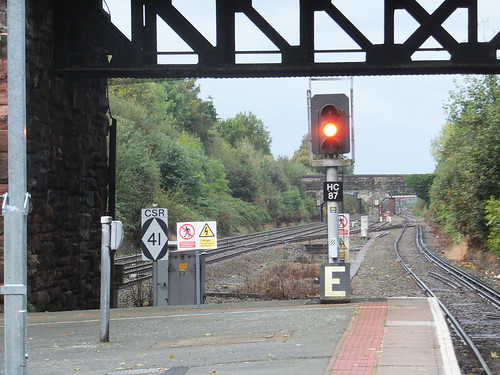 Looking towards Liverpool from platform 3 at Hunts Cross. Platform 3 is third-rail electrified for terminating Merseyrail trains.
Looking towards Liverpool from platform 3 at Hunts Cross. Platform 3 is third-rail electrified for terminating Merseyrail trains.
After a very hasty survey, I re-boarded the train I'd arrived on, now heading for Southport, and travelled on the 'last bit' of the CLC to Liverpool. The area around the modern Brunswick station appeared to be a retail park - I'll have to go back to see if any parts of the early railway infrastructure remain. Now the CLC Liverpool terminus has gone, the line descends in a tunnel to the modern sub-surface Liverpool Central before continuing to Moorfields, near the original Lancashire and Yorkshire Railway terminus at Liverpool Exchange. The train then climbs the Great Howard Street Incline to reach the 22 spans of the Great Howard Street Viaduct and the 68 spans of the Liverpool Exchange Viaduct which formerly carried the approach tracks to Liverpool Exchange.
I alighted at Sandhills station and, on the landward side of the station, immediately came to a modern industrial estate built on the site of the former CLC Huskisson Goods Depot. The aerial view of Sandhills below, taken in 1937, suggests how completely the area has changed. The Lancashire and Yorkshire lines from Liverpool Exchange appear centre left and divide near the top of the picture, curving left to Bank Hall for Southport and carrying straight on to Kirkdale for Aintree and beyond.

Sandhills in 1937: The sidings bottom left form the 'throat' of the CLC Huskisson Goods Depot. The road running horizontally near the bottom left is Sandhills Lane (Click on the image for a slightly larger version).
One of the 'units' on the industrial estate which occupies the site of the CLC Huskisson Goods Depot houses the Sandhills Area Signalling Control (ASC) which manages most of the Merseyrail network. This is an Integrated Electronic Control Centre (IECC).
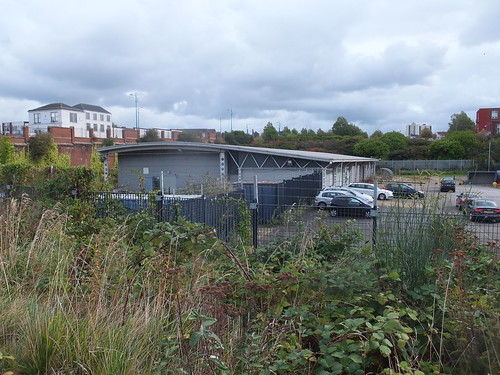 Sandhills Area Signalling Control: The road at high level in the background is Sandhills Lane and the now white painted buildings can also be seen on the 1937 photograph above.
Sandhills Area Signalling Control: The road at high level in the background is Sandhills Lane and the now white painted buildings can also be seen on the 1937 photograph above.
I then set off towards the river along Sandhills Lane so as to join Regent Road (the main dock road) and walk back towards the city, in order to see the Regent Road Scherzer Rolling Lift Bridge. This walk in described in the post On foot around Liverpool Docks. My walk ended at James Street Merseyrail Station, on the Wirral Line, where I caught a train towards West Kirby.
James Street - West Kirby
James Street station was built on the double-track Mersey railway between the railway tunnel under the Mersey and the terminus at Liverpool Central (Low Level). With the building of the balloon-shaped Liverpool Loop by British Railways, a new platform was built on the new alignment for trains approaching Liverpool. Having traversed the Loop, trains now heading for the Wirral still call at the original Mersey Railway platform, which has been modernised to match the other underground stations. The original Liverpool-bound platform still exists, in a largely un-modernised form, and now serves as a link-line between the Wirral Line and the Northern Line for rolling stock transfer. So passengers waiting for Wirral Line trains face the now-unused platform which conjures up a good idea of the station before the construction of the Liverpool Loop, indeed, it's evocative of the steam days. There's a brief description of the early days of the Mersey Railway here. The steps of the overbridge linking the two original platforms (not now in use) still proudly carries the cast builder's plate marked 'Manufactured by the Butterley Company 1885'.
 The largely un-modernised now-unused platform at James Street.
The largely un-modernised now-unused platform at James Street.
I discovered that Hamilton Square Station (at the Birkenhead end of the river tunnel) had closed a few days earlier for a period of around six months for re-furbishment. During the closure, a Rail Replacement bus service loops between Hamilton Square Station, Birkenhead Central Station, Conway Park Station then back to Hamilton Square Station. I didn't want to catch a Chester or Ellesmere Port train as that would have involved a bus transfer from Birkenhead Central to Conway Park but the first train to arrive was for New Brighton, allowing me to travel on it and change anywhere up to Bidston.
I decided to change at Birkenhead Park. This is now just a simple island platform with access from a road overbridge carrying Duke Street (further north, Duke Street is carried over the Great Float of the docks on a Scherzer Rolling Lift Bridge as I described in the post here). Originally, the Mersey Railway terminated at Birkenhead Park making an end-on connection with the Wirral Railway. There were four platforms and it must have been busy with every train terminating and reversing. The Mersey railway was electrified in 1903 but the Wirral Railway remained steam hauled until 1938 when, at last, the whole network was electrified by the LMS. There are clues to the station's former importance - extra arches on the road bridge and a too-wide formation where there were once additional tracks. As elsewhere where redundant tracks are 'lifted', a small forest is appearing.

Birkenhead Park, looking towards Hamilton Square with a Liverpool-bound train in the distance, showing its ugly station building on Duke Street.
After a few minutes, a West Kirby train arrived and I hopped aboard to complete my journey to the terminus.
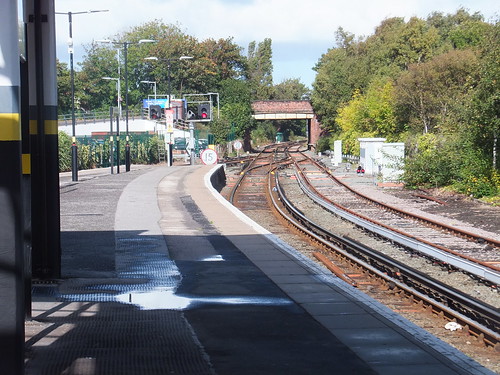 View from the island platform at West Kirby, looking towards Bidston and Birkenhead.
View from the island platform at West Kirby, looking towards Bidston and Birkenhead.
The small town of West Kirby (the population was less than 8,000 around the year 2001) looked quite attractive in the morning sun. I walked towards the promenade which looks out across the Dee Estuary. There's a Marine Lake which was being used by windsurfers. At low tide, it is possible to walk to the Hilbre Islands - a walk of about two miles each way. There were quite of few groups of walkers making their way to the islands but I had other plans and returned to the railway station, pausing to take tea and a toasted tea-cake in the cafe 'Toast' which forms part of the attractive station buildings.
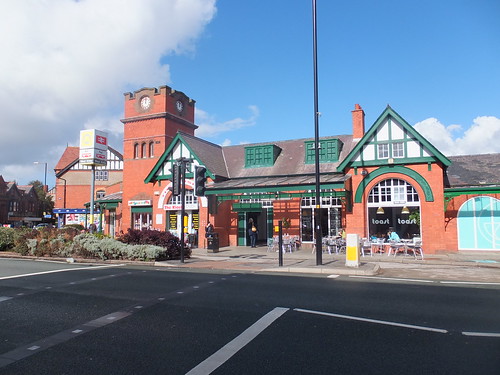 West Kirby Station from the road.
West Kirby Station from the road.
My plan was then to travel to Ellesmere Port, so I boarded the next departure - quite busy with Liverpool-bound shoppers. Normally, I would have changed for an Ellesmere Port train at Hamilton Square but, because of the refurbishment, I crossed under the river again and changed at James Street.
James Street - Ellesmere Port
The first train was for Chester but I decided to board this as far as Birkenhead Central, giving me an opportunity to look around the station, and then take an Ellesmere Port train. The station is above ground and, despite various additions and alterations (invariably unhelpful), still has a 'flavour' of the original.
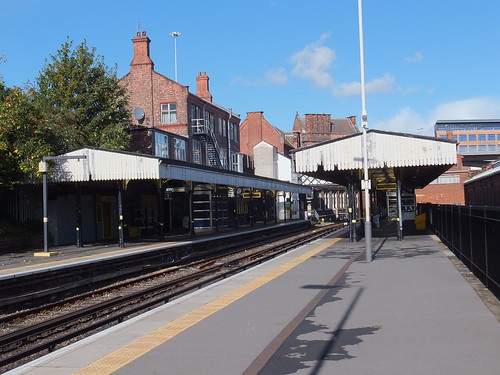 General view of Birkenhead Central, looking towards Hamilton Square and Liverpool.
General view of Birkenhead Central, looking towards Hamilton Square and Liverpool.
I caught the Ellesmere Port train which took the route I'm now familiar with to Hooton, where it turned left onto the double track to Ellesmere Port. There were some fairly major earthworks, where cuttings had been hewn through the sandstone, bringing us to Little Sutton, with an attractive stone-built station building on the Down side.
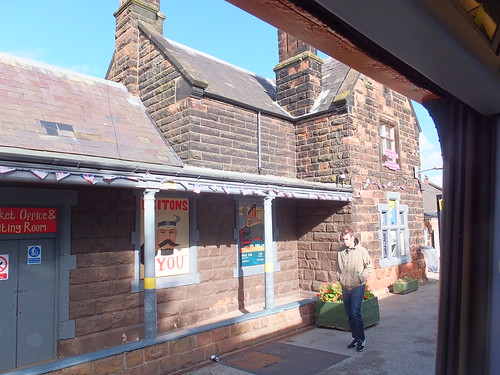 Little Sutton Station: Stone building on Down Platform.
Little Sutton Station: Stone building on Down Platform.
We had one more stop at Overpool and arrived at our destination, Ellesmere Port. However, the double track line continues beyond the station, though operated by Northern Rail, not Merseyrail (and not electrified). I left the station and walked towards the National Waterways Museum but found the roundabout leading to the M53 very unfriendly to pedestrians so, intending to go forward by a Northern Rail train, I returned to the station.
 Ellesmere Port station. Merseyrail electrics use the far platform (platform 1); Northern Rail trains use the near platform.
Ellesmere Port station. Merseyrail electrics use the far platform (platform 1); Northern Rail trains use the near platform.
Merseyrail trains arrive in platform 1 on the down line and, when unloading and loading has taken place and the Driver and Guard have changed ends, the train departs via a trailing crossover to reach the Up line for the journey back to Hooton.
 Ellesmere Port: View from platform 1 looking towards Hooton.
Ellesmere Port: View from platform 1 looking towards Hooton.
My journey onward from Ellesmere Port is described in the post Ellesmere Port - Helsby line.
My pictures
Merseyrail.
Ellesmere Port - Helsby line
In the post The Cheshire Lines Committee, I wrote about the history of that joint railway and, in the section 'THE CLC ROUTES TODAY', I outlined what remains of these lines.
Well, I decided I should make a trip over these remaining CLC lines again and, this time, take some pictures. I planned a series of journeys using the National Rail Enquiries site which I find fairly reliable and, in fact, all my connections during the day worked well.
The Saturday I chose, 4th October 2014, was rather wet in the morning but improved later with occasional light showers. I'd intended to start with the 06:37 Virgin 'Pendolino' from Wolverhampton but I arrived at the station in time to catch the earlier 'London Midland' service to Liverpool so I boarded that as far as Crewe. Crewe was rather rainswept but, arriving earlier than planned, there was an 'Arriva Trains Wales' train for Llandudno about to leave number 10 bay platform which took me to Chester prior to the train I'd planned. It was still pretty dark so I couldn't see much on the journey. The original CLC station in Chester - Chester Northgate - is long gone so my journey started at the remaining Chester station, formerly Chester General.
Chester Station
At Chester, we arrived at the long platform 3 which can hold an 18-coach train. I had a quick look outside the station but the morning was slow to get light and the rain continued so I soon ducked inside again and crossed to the island platform. I watched a 'Merseyrail' electric arrive and depart from platform 7b. I don't think I'll ever get used to third-rail electrics at Chester, as I commented in the post on an earlier trip via Chester Birkenhead and New Brighton by train (Part 1).
Various other trains arrived and departed but I was waiting for the 07:59 to Manchester via the CLC line. This was scheduled to depart from bay platform 6. The overall roof covering bays 5 and 6 at the east end of the station is now completely separate from the main overall roof so I had to 'run the gauntlet' of a section of rainswept platform to get from the main part of the station to the roofed section over the bays. The roof kept the rain off but a fairly strong wind made conditions fairly unpleasant. A Class 142 'Pacer', shut down, stood in bay 6 so that did little to lift the spirits of the small group of waiting passengers (did I mention I'm not a fan of 4-wheel railcars built of bus parts?).
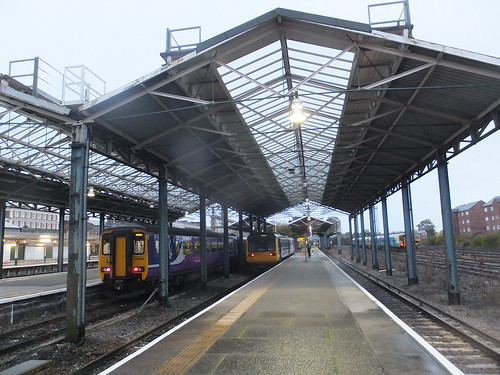 Chester Station (in the rain): Class 156 in bay 5, Class 142 in bay 6. View looking west shows that the overall roof over the bays is separate from the main station roofing.
Chester Station (in the rain): Class 156 in bay 5, Class 142 in bay 6. View looking west shows that the overall roof over the bays is separate from the main station roofing.
However, about ten minutes before departure, a class 156 appeared and stopped in bay 6, a few yards short of the 'Pacer', disgorging quite a few passengers. The driver and guard from this train transferred to the 'Pacer' and, after starting-up, the driver coupled the two sets together and the guard completed his checks and let the passengers board. I assume the 'Pacer' was available to passengers, but I didn't spot anybody use it.
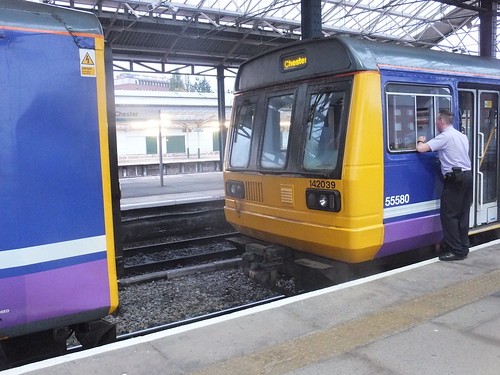 Chester Station: The driver is about to couple the Class 142 to the Class 156 as the guard looks on.
Chester Station: The driver is about to couple the Class 142 to the Class 156 as the guard looks on.
Chester - Manchester via the CLC
The colour light signal for bay 6, CR72, turned 'green' with a 'D' in the theatre-type route indicator. I presumed 'D' is for 'Down' (it's Down on the Warrington line), as opposed to 'U' (it's 'Up' heading for Crewe). We set off on the Warrington line, not more than a minute of two late, stopping all stations.
After about two and a half miles we came to Mickle Trafford Junction, with its British Railways Standard signal box, where we turned right at the single line junction to reach the CLC route which originally came from Chester Northgate (and we become an 'Up' train again). The single line now continues about four miles to Mouldsworth, where it becomes double until Altrincham. Originally, the CLC route was double throughout. The last time I was at Mouldsworth, it retained its signal box (I said it was a 'few years' since I last used the routes). Now, Mickle Trafford Junction controls the line almost to Delamere, then Greenbank signal box takes over. Mouldsworth still has its attractive stone-built station building on the Up line, apparently now a private house.
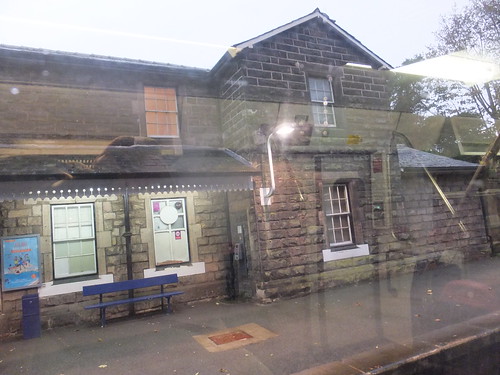 Mouldsworth stone-built station building on Up side.
Mouldsworth stone-built station building on Up side.
The next station is Delamere, set in the ancient and important Delamere Forest. The stone building on the Up side is similar to Mouldsworth, whilst on the Down side there's a simple stone shelter.
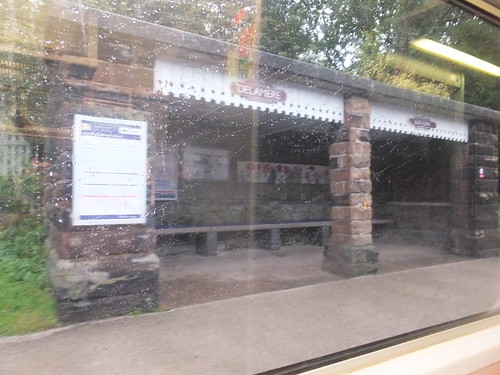 Delamere Station: Shelter on Down side.
Delamere Station: Shelter on Down side.
The Forestry Commission, in lyrical vein, describe the Forest as a "shady oasis in the midst of the agricultural landscape of the Cheshire Plain. Delamere is a place for families to let off steam, escape the crowds and find peace in the heart of the forest". The Wikipedia article here is more restrained but informative.
Another three miles took us to Cuddington station. Although the general layout of the main station building is similar to the previous stations, in this case it is brick built, as is the shelter on the Down side.
A little under two miles further on, the CLC crosses over the double track West Coast Main Line (WCML), just south of the site of Hartford Junction signal box on the LNWR where a double-track branch used to connect with the CLC at (another) Hartford Junction Signal Box. North of Hartford Junction (LNWR) the double track WCML widened to four-tracks paired by direction for a couple of miles to Acton Bridge. Hartford Junction (CLC) box closed in 1976 and this stretch of the CLC is controlled from the British Railways Standard pattern signal box at Greenbank. Hartford Junction (LNWR) is now remotely controlled from Winsford signal box, four miles south. The double track branch still links the West Coast Main Line to the CLC but, as is the modern fashion, at each end of the branch, single-line junctions are provided, eliminating the need for diamond crossings.
Another mile took us to Greenbank Station (which used to be called Hartford and Greenbank). The station building on the Up side is similar to Cuddington, also in brick. The building appears to be in private hands and I was intrigued by a Christian cross mounted on the end wall.
 Brick station building on Up side at Greenbank.
Brick station building on Up side at Greenbank.
The brick shelter on the Down side has a steeply-inclined roof which I think was originally typical of this line.
 Brick platform shelter on Down platform at Greenbank.
Brick platform shelter on Down platform at Greenbank.
The first of the chemical works around Northwich was the Brunner-Mond chemical works at Winnington, opened 1874 and still in use as part of Tata Chemicals Europe. A triangular junction to the north of the CLC line just east of Greenbank connects to a single line branch which, after one mile, reaches the works now called Northwich West. The products are soda ash, sodium bicarbonate, calcium chloride and associated alkaline chemicals.
We then passed over Northwich Viaduct, around 700 yards long dating from the 1860s. Various sources have rather different details but it's certainly Grade II listed, generally of red sandstone with a total of 47 round arches and a couple of iron spans. It crosses the Weaver Navigation, the River Weaver and the River Dane.
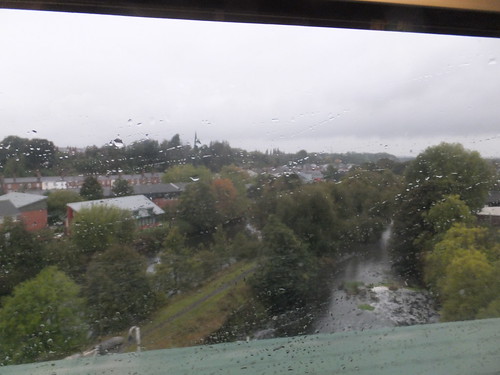 View from Northwich Viaduct in the rain.
View from Northwich Viaduct in the rain.
East of the viaduct, there's another triangular junction, this time on the south of the CLC. This leads to a single line via Middlewich to Sandbach, on the Crewe to Manchester line. I travelled once on this line, 'some years ago' when diversions were in force. I know the motive power was a Class 47, when locomotive-hauled passenger trains were still commonplace and the destination was either Manchester or Liverpool.
Back in the present, my train stopped at the impressive Northwich Station, elaborate brick station buildings provided with a glass canopy on the Up side and a platform clock made by Joyce, showing the correct time. The Down platform was originally an island platform with a glazed canopy but now the 'third line' is available for freight trains only and a 'bus shelter' has been provided for passengers awaiting trains towards Chester.
 Northwich Up side platform (sorry about the rain on the coach window).
Northwich Up side platform (sorry about the rain on the coach window).
Leaving Northwich, we passed the Lostock Chemical Works, now part of Tata Chemicals and called Northwich East, then stopped at Lostock Gralam, at the limit of the control area for Greenbank signal box. Two miles further on, we paused on the approach to Plumley station. When we restarted, I caught a glimpse of a fairly old 2-aspect colour light with a subsidiary aspect underneath. There's a crossover here and a siding on the Down side, together with an elderly wooden signal box. The station building on the Up line at Plumley is the 'standard brick design', similar to Cuddington and Greenbank. Reproduction British Rail 'totems' commemorated 'Cheshire Best Kept Station' awards - a Community Award in 2006 and Winner in 2013.
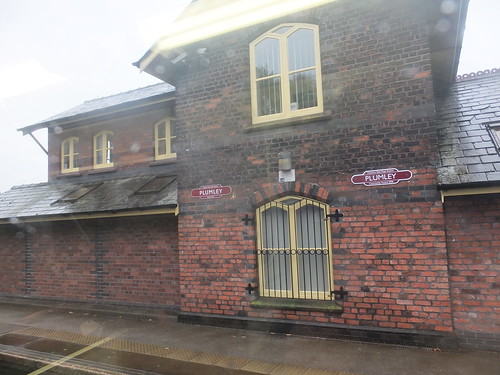 Brick former station building on Up platform at Plumley.
Brick former station building on Up platform at Plumley.
Our next stop was at Knutsford station. Like Northwich, this had rather 'posh' buildings with a glass canopy over the Up platform. Then on to Mobberley, where I failed to spot the signal box on the Down side. The following station, Ashley, had the 'standard brick design' station building on the Up side. Just under two miles took us to Hale, the last of the CLC stations on this route. There's a level crossing just at the Chester end of the station. Barriers are now provided but the former signal box, a small wooden affair which once controlled mechanical crossing gates, survives. I believe barriers were installed in 1974, controlled from Hale signal box but, subsequently, the crossing became supervised by Closed Circuit Television (CCTV) from Deansgate Junction. Hale station also boasts a rather nice glazed canopy supported on cast columns.
Altrincham
Less than a mile took us to Altrincham station. This was the last station on the Manchester, South Junction and Altrincham Railway (MSJ&AR), jointly owned by the London & North Western Railway (LNWR) and the Manchester, Sheffield and Lincolnshire Railway (MS&L). Since the MS&L were one of the partners in the CLC, an end-on junction with the MSJ&AR offered trains from Chester a direct route into Manchester. Altrincham station had two through platforms used by CLC-route trains and two bays for local services. The MSJ&AR including the two bays at Altrincham was electrified in 1931.
In 1992 it was decided to transfer the southern part of the MSJ&AR, together with parts of the abandoned CLC route into Manchester Central, to the Manchester Metrolink Light Rail Project, using the bays at Altrincham to terminate the Metrolink trams. Although CLC-route trains would be denied the MSJ&AR route to Manchester, Deansgate Junction, less than a mile north of Altrincham, already had a branch to another CLC line - the Glazebrook Jn. to Hyde Jn./Godley Jn. Although part of this route had been abandoned,a remaining section from Skelton Junction to Northenden Junction would allow CLC-route trains to take a roundabout route to Stockport, reaching Manchester via the former LNWR line.
A difficulty with this plan was that from Deansgate Junction towards Altrincham as far as the level crossing at Navigation Road, there was not space for additional running lines beyond the existing two. The solution adopted was to convert the double track between Deansgate Junction and Navigation Road into two parallel single lines, with Metrolink using the former Up line for both Inbound and Outbound trams and Network Rail using the former Down line for CLC-route trains in both directions.
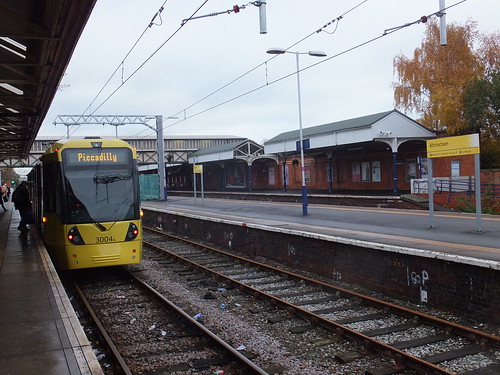 Altrincham station in November 2013. The two platforms in the foreground are used by Metrolink trains, the two in the background by CLC route trains.
Altrincham station in November 2013. The two platforms in the foreground are used by Metrolink trains, the two in the background by CLC route trains.
By former MSJ&AR, CLC and LNWR lines to Manchester
My journey continued from Altrincham with the CLC-route double track converging into a single line through Natigation Road and past Deansgate Jn. signal box, then swinging right and becoming double track again. At Skelton Jn., the line to Glazebrook is merely a stub of single track, and that is now shown as 'out of use'. Northenden Junction signal box survives, controlling the junction with the now-singled route which still extends to Chinley. For two and a half miles our route to Stockport became singled, resuming double track 1300 yards before we joined the Crewe-Manchester main line at Edgeley Junction No. 2 signal box. After our stop in platform 4 at Stockport, we took the Down Slow Line allowing us to call at Heaton Chapel and Levenshulme before finally arriving in platform 10 in Manchester Piccadilly, just 90 minutes after leaving Chester. It was still raining so I abandoned thoughts of spending time in Manchester and made my way across Piccadilly station to platform 14 to catch a Liverpool train via the CLC route.
Manchester - Liverpool via the CLC
East Midland trains provide the fast service along the CLC route to Liverpool. I think Northern Rail provide an all-stations service but I'll try that on another trip. There was a large crowd of people at Manchester Piccadilly to board the 09:37 3-car Diesel Multiple Unit, so I quickly found tip-up seat in a vestibule at the rear of the train and stayed there. At Oxford Road, many people left the train but it was still pretty crowded. We didn't stop at Deansgate, then the brick viaduct built to carry the approach tracks to Manchester Central appeared on the right. This viaduct now just carries the double track of the Manchester Metrolink Altrincham Line. At Castlefield Junction a double track diverged to our right, under a skew truss bridge which originally carried the Manchester Central lines.
This diverging route leads to Ordsall Lane Junction. Here a siding from MOSI (the Museum Of Science and Industry) converges since the museum is the site of the first main line railway terminus in the world at Liverpool Road - the original Manchester terminus of the Liverpool and Manchester Railway (L&M), opened in 1830. There's quite a bit about the museum and my actvities there as a volunteer which you can find here.
Beyond Castlefield Junction, the route from Manchester Central was carried on a lengthy lattice bridge (usually referred to as the 'Birdcage') which is now used by Metrolink trams. The picture below taken from my Liverpool-bound train shows the rather fancy red fencing on the MSJ&AR bridge, part of the canal system, the modern apartments which now occupy the quayside and the massive supports for the lattice bridge on the Manchester Central-route. The brick bridge over the canal in the background carries the diverging line from Castlefield Junction to Ordsall Lane Junction. This line has recently been electrified (electrification of the whole of the L&M route to Liverpool is currently being completed) and a number of portal structures for the Overhead Line Equipment can be seen. Finally, the sawtooth roofline just visible above the apartment building is the 1830 Warehouse of the L&M which is now part of MOSI.
 View from my DMU on the MSJ&AR.
View from my DMU on the MSJ&AR.
At Cornbrook, there was a complex series of junctions between the CLC-route to Liverpool and the MSJ&AR to allow trains to change routes as necessary. Ceding the southern part of the MSJ&AR route to Metrolink has required significant alterations. Metrolink have built a station here, visible as my train moved from the former MSJ&AR route we'd used from Piccadilly to the former CLC route to Liverpool.
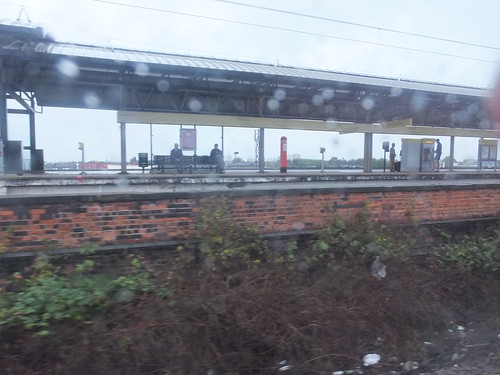 Cornbrook Station on the Manchester Metrolink.
Cornbrook Station on the Manchester Metrolink.
The massive concrete bulk of Manchester United Football Stadium passed on the right, followed by the sidings and Freightliner Terminal at Trafford Park. Electrification at 25 kV a.c. extends only as far as these yards. Travelling at a good clip, we passed through the stations at Trafford Park, Humphrey Park and Urmston, which represents the limit of the control area of Manchester Piccadilly Signalling Control Centre (there's a post describing a visit to this Signal Control Centre here). We were then in Glazebrook East Junction's control area.
We sped through Chassen Road and Flixton before passing over the Manchester Ship Canal at high level near Irlam Locks. about a mile further on, we passed Irlam station, once a destination for steam-hauled suburban trains from Manchester Central. Another mile took us to Glazebrook East Junction signal box - a British Railways Standard pattern. Glazebrook station followed and, three miles beyond, the modern station at Birchwood, visible from the nearby M6 Motorway. After Padgate, the line curved onto what was the loop line to reach Warrington town and we made our first stop at Warrington Central. The massive CLC Goods Warehouse adjacent to the station is now (what else?) apartments. Modern apartment blocks have been built over the rest of the goods yard.
 The Goods Warehouse at Warrington Central is now apartments.
The Goods Warehouse at Warrington Central is now apartments.
Warrington Central signal box takes over from Glazebrook East Junction and hands on to Hunts Cross. It's another British Railways Standard design, situated on the Down platform.
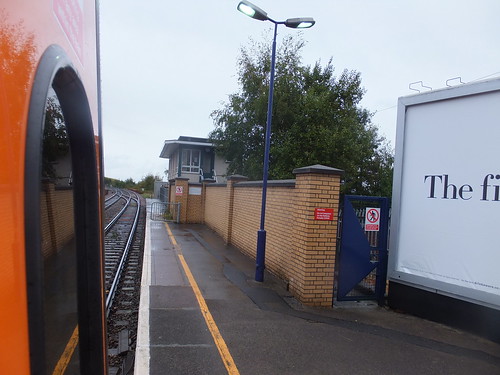 Warrington Central signal box.
Warrington Central signal box.
Warrington Central station buildings, with their glazed canopies, are quite impressive - I must try to return with time to appreciate them better.
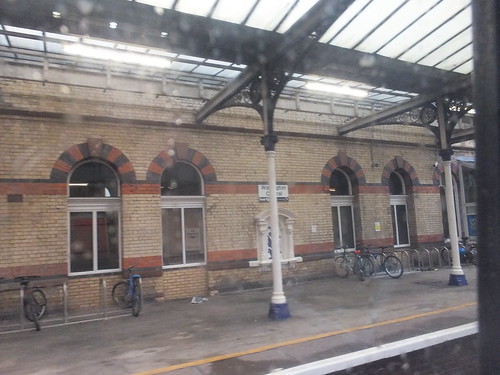 Station buildings on Up platform at Warrington Central.
Station buildings on Up platform at Warrington Central.
My train departed from Warrington across the 350 yard Warrington Viaduct, then crossed the West Coast Main Line (4-track, paired by direction between Warrington Bank Quay and Winwick Junction). We accelerated rapidly, flew through Sankey station and were soon braking for our stop at Widnes. Whereas the CLC provided a direct line for fast trains and a loop into the town at both Warrington and Widnes, at Warrington the direct line was abandoned but at Widnes, the loop into the town was abolished and the present Widnes station is actually Farnworth station renamed. I spotted a wooden 'Farnworth' nameboard dumped beside the station building but I couldn't determine if it was historic or a modern copy. The large brick station building on the Down side is quite attractive, but boarded-up and separated from the platform by a fence.
 Farnworth station building, now serving as 'Widnes'.
Farnworth station building, now serving as 'Widnes'.
The next five miles took us through stations at Hough Green, Halewood and Hunts Cross. The line straight ahead was the CLC to Liverpool Central but, from Hunts Cross, only Merseyrail trains operate the line so my train turned right onto the Down Hunts Cross Chord, joined the Crewe - Liverpool line at Allerton Junction signal box (another British Railways Standard Pattern signal box, this time with an 'oversize' brick-built ground floor) and came to a stand in platform 2 at the modern station of Liverpool South Parkway. This steel-and-glass transport interchange opened in 2006 and I first used it myself in 2010 when attending an OLCO Annual General Meeting (described here).
The train had only a five and a half mile dash to reach Liverpool Lime Street but I decided to 'bail out' and continue to Liverpool on the former CLC route, now operated by Merseyrail. My brief description of of the journey from Hunts Cross to Liverpool is in the post More Merseyrail.
 Allerton Junction Signal Box seen from Liverpool South Parkway Station. The Crewe lines are in front of the signal box - Up Fast, Down Fast, Up Slow, Down Slow. The diverging lines behind the signal box are Up Hunts Cross Chord and Down Hunts Cross Chord. The lines diverging further to the left serve Northern Rail's Allerton Traction Maintenance Depot (TMD).
Allerton Junction Signal Box seen from Liverpool South Parkway Station. The Crewe lines are in front of the signal box - Up Fast, Down Fast, Up Slow, Down Slow. The diverging lines behind the signal box are Up Hunts Cross Chord and Down Hunts Cross Chord. The lines diverging further to the left serve Northern Rail's Allerton Traction Maintenance Depot (TMD).
My pictures
North Wales Line (Crewe - Llandudno) (Pictures of Chester station).
CLC Chester - Manchester.
Manchester Metrolink.
Manchester Area Rail.
CLC Manchester - Liverpool.
Liverpool area rail.
Clicking on an image below gives an uncropped or larger image. Searching 'My pictures' below allows viewing or downloading of larger images.
HISTORICAL NOTES
A railway run by a committee? The Cheshire Lines Committee (or just 'CLC') successfully operated 143 route miles of railway in Lancashire and Cheshire until nationalisation of the railways in 1948. It sometimes styled itself 'The Cheshire Lines Railway' although a little over half of the railway was in Lancashire and had no locomotives of its own.
In the 1830s, the success of the early trunk railways like the The London & Birmingham Railway led to a turbulent period of rapid railway development as new railways sought a 'slice of the action' and existing railways defended their own profitability.
The Great Northern Railway (GNR) was set up in 1846. It built and operated what became the southern part of the East Coast Main Line, with the North Eastern Railway operating further north and the North British Railway completing the route to Scotland. The Manchester, Sheffield and Lincolnshire Railway (MS&L), formed by amalgamations in 1847, was a smaller railway with major ambitions involved in many political machinations. The GNR and the MS&L set up the Cheshire Lines Committee (CLC) in 1862 to operate proposed routes in Cheshire. In 1865 the Midland Railway (which had been formed in 1844 by the amalgamation of three railways) became a third, equal partner in the CLC.
The birth of the CLC was largely due to Edward Watkin (later Sir Edward Watkin) who was a prolific railway entrepreneur. In 1897 the MS&L changed its name to the Great Central Railway (GCR), when its London Extension Railway to Marylebone (sometimes called the Great Central Main Line) was being built. The MS&L (later GCR) provided the motive power for the CLC and, initially, the partners provided goods and passenger rolling stock although later the CLC made its own provision.
Under Watkin's direction, the CLC developed four principal routes of its own, with numerous connections to other railways:-
Route 1. Liverpool Central to Manchester Central via Warrington Central.
Route 2. Chester to Manchester Central.
Route 3. Halewood/Hunts Cross to Southport Central via Aintree.
Route 4. Glazebrook to Hyde Jn./Godley Jn. via Stockport Tiviot Dale.
These routes are shown on the Pre-Grouping map below (the Chester route only from Mobberley to Manchester, I'm afraid):-

On the above map, CLC routes carry the colours of all three partners:-
Great Northern Railway - Brown
Great Central Railway (formerly MS&L) - White/Red
Midland Railway - Green
Click for larger view.
Route 1. Liverpool Central - Manchester Central
By 1873 the CLC was operating a Liverpool to Manchester service, in competition with the London & North Western Railway (LNWR) and the Lancashire and Yorkshire Railway (L&YR) routes. The non-stop CLC trains completed the journey in around 40 minutes and by 1900 the CLC was carrying more passengers between the cities than the LNWR and L&YR combined.
Liverpool Central
Initially, services terminated rather inconveniently at Brunswick, south of the city centre, but in 1874 Liverpool Central was opened in the heart of the city.
 Liverpool city in 1946. The long trainshed of Liverpool Central station is near the top right and the two trainsheds of Liverpool Lime Street station are top left. Click on image for a slightly larger view.
Liverpool city in 1946. The long trainshed of Liverpool Central station is near the top right and the two trainsheds of Liverpool Lime Street station are top left. Click on image for a slightly larger view.
 Railway Clearing House Map of Liverpool Railways in 1909, showing CLC Lines in Brown (The Liverpool Central end of Route 1 is bottom right, part of Route 3 is top right).
Click for other sizes or to download.
Railway Clearing House Map of Liverpool Railways in 1909, showing CLC Lines in Brown (The Liverpool Central end of Route 1 is bottom right, part of Route 3 is top right).
Click for other sizes or to download.
Widnes
The CLC provided a'fast' route for through trains, whilst the GCR and MR built a loop with a passenger station nearer the town.
Warrington Central
Again, the CLC provided a 'fast' route for through trains and a loop into the station in the town, as shown on the map below.
 Warrington Central, on a loop line to the main CLC.
Warrington Central, on a loop line to the main CLC.
Manchester Central
At first, the CLC line was served by a temporary terminus in Manchester but by 1880 the CLC had opened Manchester Central, with its impressive trainshed. The 210 foot span of the trainshed was exceeded only by Barlow's trainshed at St. Pancras (a visit to St. Pancras is described here). The approach tracks to Manchester Central station had to be raised above ground level to carry the lines over existing roads. Both the MS&L and MR also had running powers into the LNWR's congested London Road terminus.
 Manchester Central Station in 1948, with Deansgate Goods Depot behind (from a damaged negative). Click on image for a slightly larger view.
Manchester Central Station in 1948, with Deansgate Goods Depot behind (from a damaged negative). Click on image for a slightly larger view.
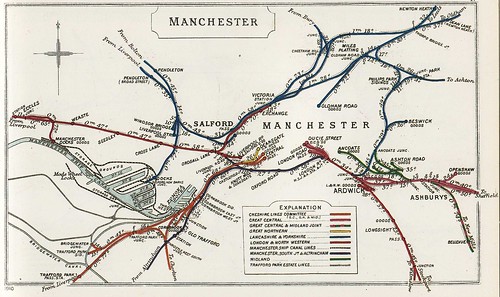 Railway Clearing House Map of Manchester Railways in 1910, showing CLC Lines in Brown. Trains from Chester direction (Route 2, described below) used the MS&LR to Old Trafford Jn. where they diverged to join the CLC Liverpool route to Manchester Central at Cornbrook West Jn.
Railway Clearing House Map of Manchester Railways in 1910, showing CLC Lines in Brown. Trains from Chester direction (Route 2, described below) used the MS&LR to Old Trafford Jn. where they diverged to join the CLC Liverpool route to Manchester Central at Cornbrook West Jn.
Click for other sizes or to download..
In 1903, the Midland Railway opened the Midland Hotel, a few yards from the entrance to Manchester Central. The hotel remains open today (see 'THE CLC ROUTES TODAY' below).
Route 2. Chester Northgate to Manchester Central
The CLC route to Manchester started at Chester Northgate station. The Great Central also developed its own network of lines west of Chester both across the Wirral and to Wrexham. The CLC line passed through Northwich, where the Brunner-Mond chemical works at Winnington opened in 1874 (and survives today) generated significant freight business. The CLC route continued to an end-on connection at Altrincham with the Manchester South Junction & Altrincham Railway (MSJ&AR). This was a joint line operated by the LNWR and the MS&L which led to what is now Manchester Piccadilly but at Old Trafford Jn. CLC trains could be diverted to join the CLC Liverpool route at Cornbrook West Jn., reaching Manchester Central station after a further mile..
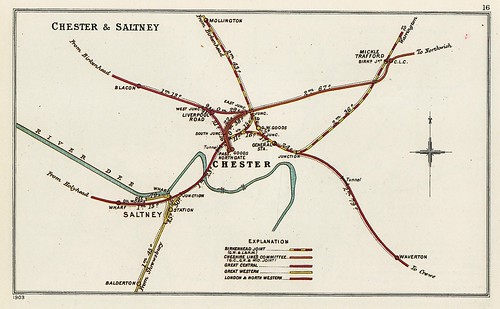
Railway Clearing House Plan of Chester area in 1910 showing the CLC lines in Brown.
Click here for larger image
Route 3. Halewood/Hunts Cross to Southport Central via Aintree
A triangular junction between Hunts Cross and Halewood led to the CLC line to Aintree, opened in 1879. The line passed the city of Liverpool on the landward side and tunneled under the L&YR lines near Kirkdale to reach Aintree. A further triangular junction served a branch to Huskisson, within sight of the L&YR Sandhills station. Beyond this triangle, a purely Midland Railway branch diverged and ran for just over two miles to Langton Dock. These important connections to Liverpool Docks generated significant freight revenue. The line was extended to the important resort of Southport by 1881, nearing the coast at Ainsdale and continuing to Southport, where it turned to landward to terminate on the shore side of Lord Street. However, this extension was always disadvantaged because Liverpool to Southport was 31 miles by the CLC route, compared with 18.5 miles on the L&YR route which was electrified.
Southport Lord Street
The railway built a five platform terminus on the seaward side of Lord Street, as shown on the aerial photograph below.
 Southport Lord Street Station (foreground) in 1938. Southport Chapel Street station is in the background. Click on image for a slightly larger view
Southport Lord Street Station (foreground) in 1938. Southport Chapel Street station is in the background. Click on image for a slightly larger view
Route 4. Glazebrook to Hyde Jn./Godley Jn. via Stockport Tiviot Dale
The line from Glazebrook Jn. is shown in the Pre-Grouping map above. The junction at Glazebrook allowed trains from Liverpool direction to divert through Timperley to Stockport Tiviot Dale, where the CLC at low level crossed under the Stockport Viaduct of the LNWR route to Manchester. Beyond Stockport, triangular junctions allowed trains to join the Manchester to New Mills line, a joint GCR/MR affair, heading towards or away from Manchester. Finally, a further joint GCR/MR triangular junction allowed trains to join the original MS&L main line from Manchester to Sheffield again heading towards or away from Manchester. These connections allowed both the GCR and MR ready access to the CLC network from their traditional routes.
THE CLC ROUTES TODAY
The original CLC routes are shown on the Pre-Grouping map above. As a result of the 'Grouping' in 1923 both the LNWR and the MR became part of the London Midland and Scottish Railway (LMS) whilst the GNR and GCR became part of the London & North Eastern Railway (LNER). The CLC continued with the LMS and LNER as partners until 1948 when nationalisation brought all railways together in British Railways.
Many of the railways shown on the above Pre-Grouping map no longer exist. As far as former CLC routes are concerned, it's still possible to travel from Liverpool to Manchester via Warrington Central using the CLC route but the network is much simplified and the arrangements at either end are radically different since both Liverpool Central in its original form and Manchester Central have been abolished. It's also possible to travel from Chester to Manchester on the CLC route - again the original terminal stations have been lost and routes have been reconfigured and simplified. The whole of the line from Halewood/Hunts Cross to Southport Lord Street has gone. Fragments of the Glazebrook to Hyde Jn./Godley Jn. route remain in use although reconfigured and Glazebrook and Godley are no longer junctions.
Route 1 today: Liverpool - Manchester
In my post Day Trip to Southport and Liverpool (Part 2) I outlined the changes made when both Liverpool Exchange (L&YR) and Liverpool Central (CLC) were closed. British Railways drove a tunnel under the city centre so that electric trains from Southport could join up with the lines which had served Liverpool Central and continue on the former CLC line to the limit of third-rail electrification at Hunts Cross. The electrified line from Southport to Hunts Cross now forms part of the Northern Line of the Merseyrail network. Diesel trains from Liverpool Lime Street reach Hunts Cross on the CLC route via the connection at Allerton Junction and continue through Warrington Central to Manchester where they now gain the former MSJ&AR at Castlefield junction and continue to Manchester Oxford Road and Manchester Piccadilly.
Liverpool Central
The Liverpool Central CLC station has gone, but is recalled on the 'Disused Stations' site here.
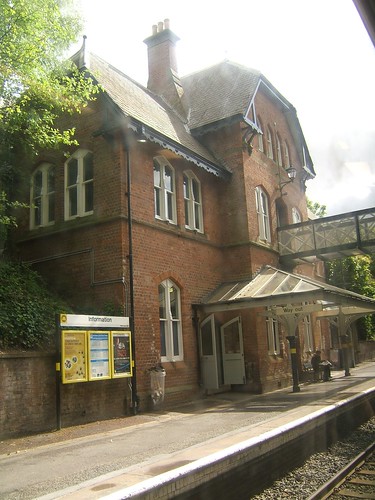
The attractive Cressington Station, on the Liverpool Central to
Hunts Cross Line, survives as part of the Merseyrail network.
Widnes
The loop line has been long abandoned but Widnes Central station which formerly served the town is described on the 'Disused Stations site here. Farnworth station on the direct line is now renamed 'Widnes'.
Warrington Central
In Warrington, the 'fast' route for through trains has been abandoned (and largely built over) but trains continue to call at Warrington Central station within the town.
Manchester Central
Manchester Central is no longer in use as a station, but its railway days are remembered here. The train shed at Manchester Central was retained as an exhibition/conference/event centre, originally called 'G-MEX' but now calling itself Manchester Central.
 The 'country end' of the former trainshed at Manchester Central.
The 'country end' of the former trainshed at Manchester Central.
By 1903, the Midland Hotel had opened and remains open today - more details here.
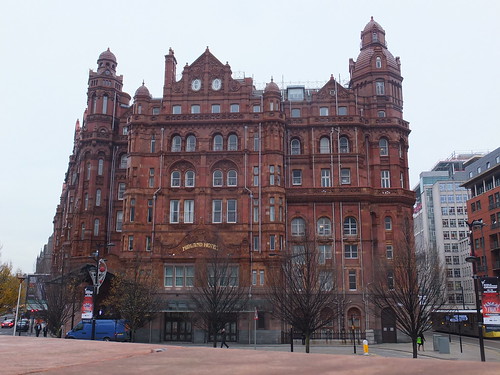 The Midland Hotel, Manchester.
The Midland Hotel, Manchester.
The approach tracks to the station had to be raised above ground level to carry the lines over existing roads. The tracks may have gone but this impressive bridge (which now carries a car park) still looms over Great Bridgewater Street.
 Bridge formerly carrying approach tracks to Manchester Central.
Bridge formerly carrying approach tracks to Manchester Central.
A little further out, a complex lattice bridge was used to carry the CLC tracks and this now carries the trams on the Altrincham route of Manchester Metrolink.
 Bridge formerly carrying approach tracks to Manchester Central now part of the 'Metrolink' system.
Bridge formerly carrying approach tracks to Manchester Central now part of the 'Metrolink' system.
Route 2 today: Chester - Manchester
Chester Northgate station was closed in 1969 but it's documented on the 'Disused Stations' site here. A connection at Mickle Trafford now allows trains from the former LNWR station at Chester to gain the CLC route. Northwich still has its chemical works. For a number of years, the Brunner-Mond works was owned by Imperial Chemical Industries (ICI). It is now part of Tata Chemicals Europe. At the Manchester end of the route, since the former MSJ&AR route is now part of the Manchester Metrolink light rail network, trains to Manchester on the former CLC route now diverge at Deansgate Junction (near Altrincham) to reach the Glazebrook - Godley line at Skelton Junction. They then take the Stockport line at Northenden Jn., joining the former LNWR route at Edgeley Jn. and continuing via Stockport to Manchester.
Although the connection from Chester to the former Great Central lines across the Wirral and to Wrexham has been lost, the line from Wrexham through Shotton High Level to Bidston survives as 'The Borderlands Line' and a recent journey is described in the post By rail to Liverpool (Part 1).
Route 3 today: Halewood/Hunts Cross - Southport
All the tracks have been lifted but most of the route can still be made out on satellite photographs. The 'Disused Stations' site has comprehensive entries on the stations along the line - for example Gateacre. Aintree Central is documented here - it lay only a few yards from the surviving Aintree station, described in my post here.
Southport Lord Street
Southport Lord St. and the northern part of the line was closed to traffic in 1952. Refer to the 'Disused Stations' article here. The local newspaper 'The Southport Visiter' carried a report of the last day at Lord St Station on Tuesday, 8th January 1952:-
Southport has finally lost one of its railway stations. During its 68 years of existence, Lord St Station has acted as a gateway to Southport for hundreds of thousands of visitors. But the last ticket has been collected, and the gateway is closed and barred. Amid signs of regret history was made on Saturday night when the last trains left and arrived at the station. The Railway Executive made their decision to close the line between Southport and Aintree because it was found it was losing £29,000 a year. Southport Town Council made no objection to the proposal but regular passengers fought to keep the line open. The scene was witnessed by several hundred people 207 of whom bought tickets for the last journey to and from the station.
Leaving Lord St on the 5.30 pm train to Liverpool passengers changed at Gateacre or other stations and joined the last Liverpool to Southport train which was due back at Southport at 7.44 pm. Actually it arrived at the station at 7.41 pm. Among those who made the journey for sentimental reasons was Mr Francis J Weld who travelled on the first train in 1884."Having ridden on the first train I thought I'd travel on the last", he told me. As a boy of 10, he, his father and his sister got up at 6.30 in the morning and travelled from Southport to Aintree on the first train to leave Southport. He said it was with great excitment that as a boy he watched the line being built. One of the implements used to cut out the line was called the "American Devil," which was driven by a donkey engine.He remembered the road being raised at Weld Rd to allow the line to pass underneath and the difficulty experienced when the Esplanade was built. "High seas kept washing the workings away". Mr Weld recalled the send off given to the first train. "We changed at Aintree and waited half an hour and caught the next train back, the services were better in those days".
There was no official ceromony for the closure. Mr T.C Byrom District Passenger Superintedent of Liverpool saw the train off accompanied by Mr E Hollis Stationmaster. Right on time Porter William Halsall former Southport goalkeeper blew his whistle and the 5.30 train pulled out of the station. At stations down the line small groups of people assembled to see the last train through, whilst at others a group of youths on the train set off fireworks. On the return journey some of the passengers held a private tea party and more fireworks were set off. As the train pulled into Lord St Station Driver J Bentham of Southport gave a loud blast on the whistle and there was a half hearted cheer from the people who had gathered to see the last train arriving. A number of people refused to give up their tickets as they wanted to keep them as souveniers. After the passengers had alighted the train backed slowly out of the station to the explosions of fog detonators placed on the line. When the refreshment rooms and bar closed Shunter William Beck oldest employee with 46 years service closed the big iron gate for the last time and then went round to put out the lights in the station.
'The Southport Visiter' is one of 100 regional newspapers now owned by the Trinity Mirror Group. There is an online version of the newspaper here.
The railway has gone from the CLC Southport terminus, but the station building itself has recently been restored as a hotel and the station area is home to a supermarket.
Route 4 today: Glazebrook - Hyde Jn./Godley Jn.
Part of the Glazebrook to Godley line remains in use from near Timperley for trains to and from Chester via the CLC through Northwich. As described above, the MSJ&AR originally formed part of the route into Manchester used by CLC but that route is now part of the Manchester Metrolink light rail network. Trains to Manchester now diverge at Deansgate Junction to reach the Glazebrook - Godley line at Skelton Junction, taking the Stockport line at Northenden Junction, joining the former LNWR route at Edgeley Jn. and continuing via Stockport to Manchester. Freight trains can still use the Cheadle branch, now singled, from Northenden Junction, connecting with the former MR lines at New Mills.
The CLC line through Stockport Tiviot Dale closed in 1967. Refer to the splendid 'Disused Stations' site here for more details.
Related posts on this site
The Cheshire Lines Committee Routes Today.
Signalling on the former Cheshire Lines Committee in the 1950s
Related articles on other sites
Cheshire Lines Committee (Wikipedia).
Cheshire Lines Committee (LNER Encyclopedia).
Cheshire Lines Committee (8D Association).
Southport Lord St station (Wikipedia).
Railway Books
[1] 'Railway Stations in the North West' by Gordon Biddle, published by Dalesman Publishing Co. Ltd. (ISBN: 0 85206 644 9).
[2] 'Lost Railways of Lancashire' by Gordon Suggitt, published by Countryside Books (ISBN: 9 781853 068010).
[3] 'An Illustrated History of Liverpool's Railways' by Paul Anderson published by Irwell Press (ISBN 1-871608-68-6).
[4] 'A Regional History of the Railways of Great Britain: Volume 10 The North West' by G. O. Holt, revised Gordon Biddle published by David & Charles (ISBN: 0946537 34 8).
[5] 'The Heyday of Steam around Manchester' by Tom Heaviside published by Ian Allen Ltd. (ISBN 0 7110 2329 8).
[6] 'An Illustrated History of the Cheshire Lines Committee' by Paul Bolger published by Heyday Publishing Company (ISBN 0 947562 00 1).
#
[7] 'The Cheshire Lines Committee: Then and Now' by Nigel Dyckhoff published 1984 by Ian Allen Ltd. (ISBN 0 71101410 8).
Track diagrams
The CLC in the 1950s:-
'British Railways Layout Plans of the 1950s: The John Swift Collection' Vol 13: Cheshire Lines Committee and associated Great Central Lines', published by the Signalling Record Society (ISBN 1 873228 17 1).
The lines remaining today:-
'Railway Track Diagrams: Book 4 Midlands & North West' (3rd edition, 2013), published by TRACKmaps (ISBN 978-0-9549866-7-4).
My pictures
General
Liverpool.
Manchester.
Railway
Merseyrail.
Manchester Area Rail.
Manchester Metrolink.
[8-Oct-2014: General minor revisions, 14-Oct-2014: Book [7] added]

 Enclosing wall for Sandon Graving Docks, built 1848, featuring Jesse Hartley's 'Cyclopean' masonry.
Enclosing wall for Sandon Graving Docks, built 1848, featuring Jesse Hartley's 'Cyclopean' masonry.
 A Lock Keeper's Office by Jesse Hartley, illustrating his attention to detail and build quality.
A Lock Keeper's Office by Jesse Hartley, illustrating his attention to detail and build quality.
 Jesse Hartley Dock Wall in stone with In-Out gates flanked by round turret-like stone pillars (slotted for sliding gates) with matching stone Gatekeeper's Office (incorporating a chimney).
Jesse Hartley Dock Wall in stone with In-Out gates flanked by round turret-like stone pillars (slotted for sliding gates) with matching stone Gatekeeper's Office (incorporating a chimney).

 Victoria Tower from the river.
Victoria Tower from the river.

















































